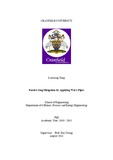JavaScript is disabled for your browser. Some features of this site may not work without it.
| dc.contributor.advisor | Yeung, Hoi | |
| dc.contributor.author | Xing, Lanchang | |
| dc.date.accessioned | 2015-08-19T14:36:06Z | |
| dc.date.available | 2015-08-19T14:36:06Z | |
| dc.date.issued | 2011-08 | |
| dc.identifier.uri | http://dspace.lib.cranfield.ac.uk/handle/1826/9339 | |
| dc.description.abstract | This work is to develop a passive slug mitigation technique based on a novel flow conditioner, wavy pipe, through laboratory experiment and numerical simulation. The wavy pipe has been applied to two types of slug flows: severe slugging in pipeline/riser systems and hydrodynamic slug flow in horizontal pipelines. The experiment of severe slugging mitigation was conducted on the 2” and 4” pipeline/riser systems in the Three-Phase Test Facility in PSE (Process Systems Engineering) Laboratory. The flow regimes in the pipeline/riser systems have been classified into four categories, i.e. severe slugging, transitional severe slugging, oscillation flow and continuous flow. Experimental results have revealed that: (1) the severe slugging region in the flow regime map can be reduced by applying a wavy pipe; (2) the wavy pipe is more effective when there is a pipe section of an appropriate length between its outlet and the riser base; (3) a smaller severe slugging region can be obtained with a longer wavy pipe (of more bends); (4) even if there is no flow regime transition due to the application of a wavy pipe, the severity of the severe slugging and oscillation flow can be reduced instead. The effects of the wavy pipe have been summarised as reducing the slug length in the pipeline/riser system. For severe slugging the wavy pipe works by accelerating the movement of the gas phase in the pipeline to the riser base to initiate the bubble penetration stage; for the oscillation flow the wavy pipe works by mixing the two phases of gas and liquid. Two-dimensional CFD models of the 4” pipeline/riser and pipeline/wavy-pipe/riser systems were developed in Fluent (Release 6.3.26) and the effects of the geometrical parameters and location in the pipeline of the wavy pipe on severe slugging mitigation were investigated numerically. The model predictions of the flow regime transition and slug frequency in the pipeline/riser system agree with the experimental data well. It has been concluded from the simulation that: (1) for a given pipeline/riser system experiencing severe slugging, the severe slug length can be reduced further by increasing the amplitude or length of the wavy pipe, respectively; however, the mean, maximum and fluctuation amplitude of the drag and lift forces on the wavy pipe increase with the increase of the wavy pipe amplitude and the mean, maximum and fluctuation amplitude of the differential pressure across the wavy pipe increase with the increase of the wavy pipe length; (2) the location of the wavy pipe relative to the riser base has significant effects on the performance of wavy pipe; an optimum location of the wavy pipe exists for a pipeline/riser system at given operating conditions. The wavy pipe in a horizontal pipeline experiencing hydrodynamic slug flow was tested on a two-phase test facility in PSE Laboratory. The wavy pipe has been found to be able to mitigate the adverse impacts of hydrodynamic slug flow on the downstream facilities. It has been concluded that the wavy pipe works as a mixer which is able to agitate the gas/liquid two phases by its upward and downward limbs. More gas entrainment is introduced into the slug body in the wavy pipe. The entrained gas distributes in the slug body extensively due to the agitation effects of the wavy pipe. However, the flow tends to recover after a certain distance downstream of the wavy pipe. The horizontal wavy-pipe systems under hydrodynamic slug flow were modelled applying STAR-OLGA coupling. The mixing effects of the wavy pipe on gas/liquid two-phase flow identified in the experiment can be presented by the coupling model reasonably well. The effects of the geometrical parameters of the wavy pipe, i.e. amplitude and length, on hydrodynamic slug mitigation were examined. It has been concluded that: (1) a wavy pipe of higher amplitude does not always introduce better mixing effects because the longer upward limbs allow more liquid to accumulate thus the liquid slugs tend to reform; a wavy pipe with amplitude of 1.8d is more desirable than those of 1.1d and 2.5d (d the pipe diameter); (2) a wavy pipe of more bends (7 bends, L/d = 20.4, L the length of wavy pipe) is more favourable to mix the gas/liquid two phases than the shorter ones (5 bends, L/d = 16.5; 3 bends, L/d = 11.1) because more space and time can be provided for the two phases to interact with each other. The forces acting on a single bend induced by hydrodynamic slug flow were investigated using STAR-OLGA coupling. The predicted peak force on the bend agrees with the experimental data in the literature. The force components on different areas of the bend wall can be presented by the 3-D STAR model. The pressure-induced force contour plots have shown the most vulnerable part on the bend wall prone to mechanical damage. | en_UK |
| dc.language.iso | en | en_UK |
| dc.publisher | Cranfield University | en_UK |
| dc.rights | © Cranfield University 2011. All rights reserved. No part of this publication may be reproduced without the written permission of the copyright owner. | en_UK |
| dc.title | Passive slug mitigation by applying wavy pipes | en_UK |
| dc.type | Thesis or dissertation | en_UK |
| dc.type.qualificationlevel | Doctoral | en_UK |
| dc.type.qualificationname | PhD | en_UK |
